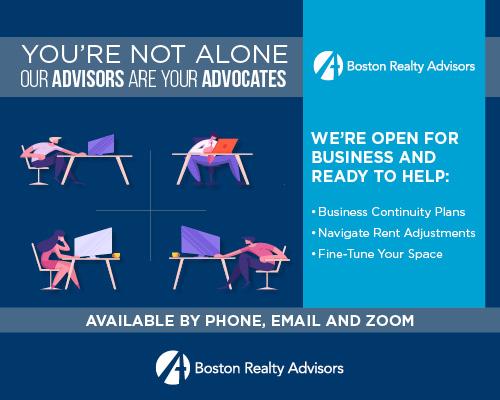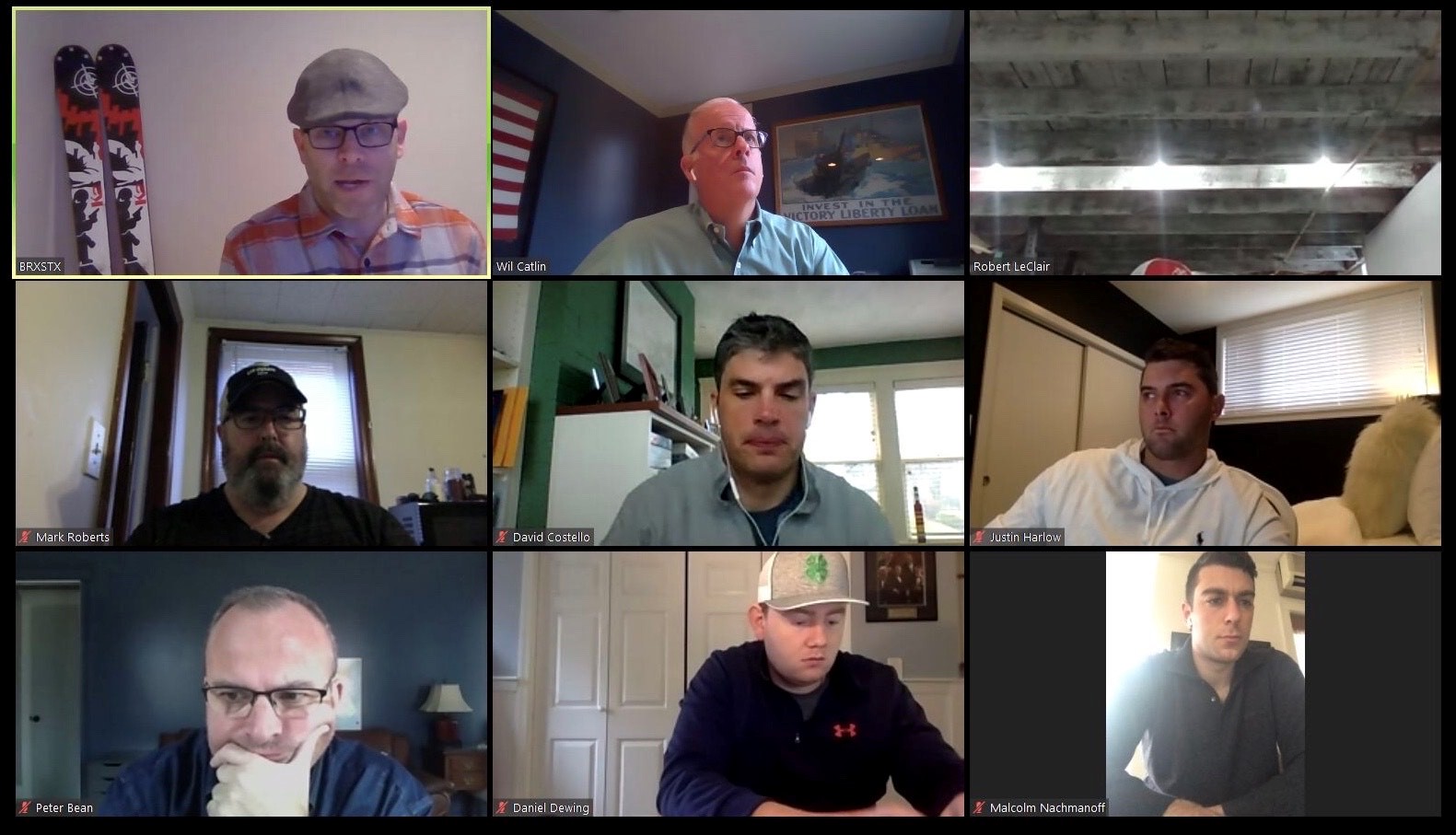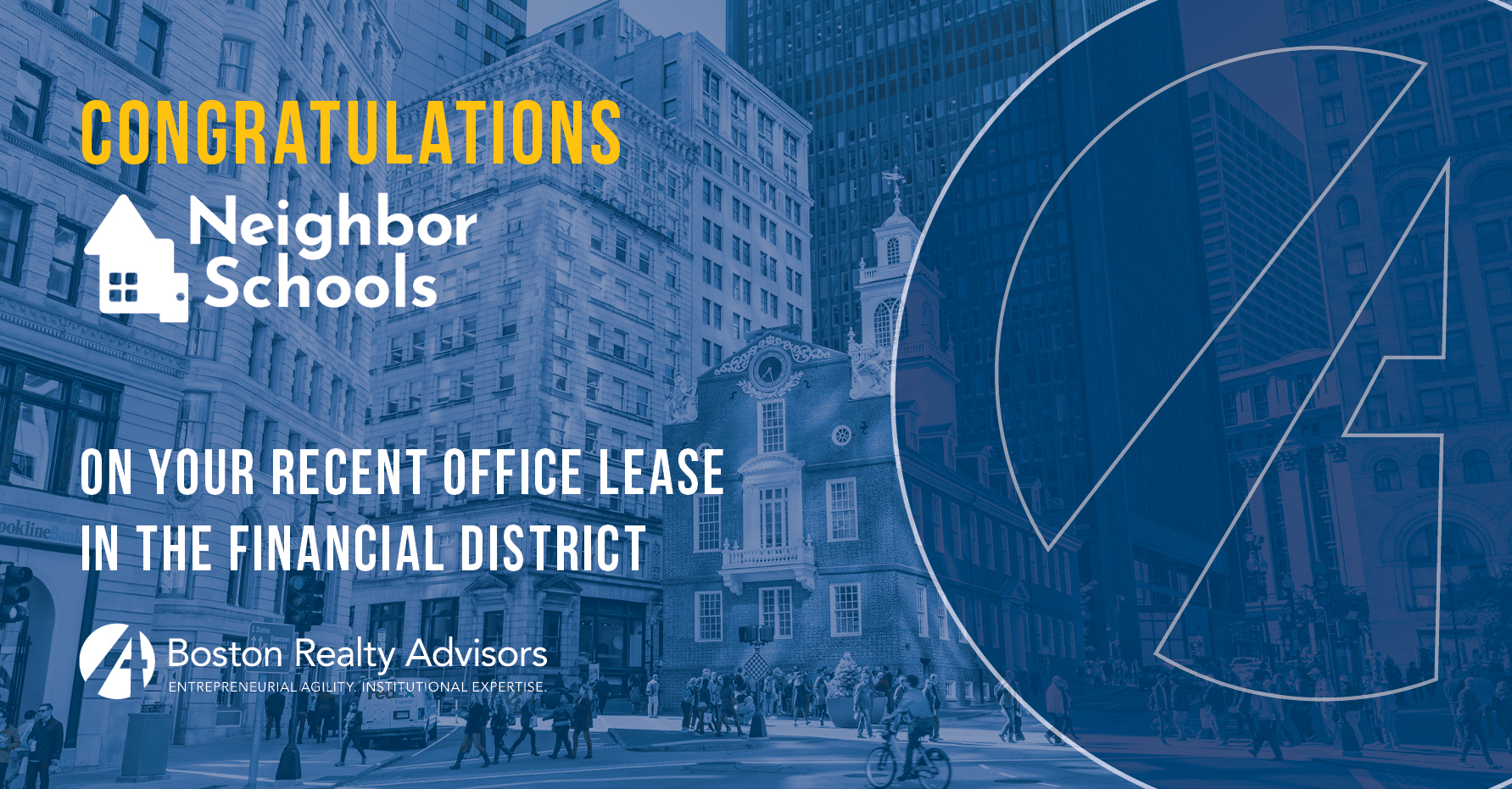
Please reach out with any questions or concerns. We are here for you.

Please reach out with any questions or concerns. We are here for you.
By Wil Catlin | March 30, 2020

We are in the middle of the largest test of remote work in history. As such, most of the national workforce is going through many “first times” together. Some of us have enjoyed remote access for years, while others are figuring it on the fly. All of us are determining how to be productive in a new environment. Here are some tips to help you navigate this new normal.
Breathe
Many companies, including Boston Realty Advisors, are set up virtually and are open for business. Everyone has had a smartphone since the beginning of time. We answer emails in bed, on the toilet and during vacation. Now is not the time to be a deer caught in the headlights. It is a time to lead, advise and differentiate. Take a breath, keep your business hat on and forge ahead.
Communicate
In all scenarios – good, fun, challenging and daunting – communication is key to professional success. Today and for the next couple of months, we need to lead with empathy and be clear. In a world of an abundance of data, new technology and artificial intelligence – Emotional intelligence is a key skill that will serve you and your clients today and into the future.
Engage, Connect & Care
Speak with your clients. Everyone is in the need of some level of advisory or will simply need an ear. Be there. Ask about family. Discuss your business. Ask about their business . Plan forward and be direct, “How can I help?”
When in question, pick up the phone and ask. Do not overdo it and be authentic. Your authenticity and thoughtfulness will speak volumes and have a lasting impression.
Top of Mind
Be relevant and present. Stay on point and add value. If you’re already active on social media, you have some built in training. Do not share or post just to check the box. That’s the fastest route to being ignored. Share industry news to be relevant. Share what’s working for you during this temporary insanity. Share a list of neighborhood restaurants that are delivering. Be thoughtful and get beyond the echo chamber to stand apart.
Self Starter
So much of our daily fabric has already changed. Try not to change too much more of your workday. Wake up at the same time and get ready for work. Most of you are in a role where being a self-starter is a requirement. It’s time to find or refind that self-starter in you. Be ready to work and lead by example.
Dedicated Space
You will need to define a space to work within your home. This is a space for you to habitually go to and a place that’s understood and respected as your work area. If you’re tight on space, a dedicated chair at the kitchen table will suffice. Tips include – Identify space with natural light; consider a sturdy desk; invest in a comfortable office chair; provide yourself with a good mouse, keyboard, and headset; and pay for the strongest internet connection possible. Perhaps, now is the time to invest in that stand-up desk you’ve been talking about.
Munchies
Try not eating at your home workspace. It’s both a distraction and a bad habit. Think about it. Your kitchen is just a few steps away. When was the last time you sat down with your spouse or kids to have lunch? You’re home. Take the time to sit down with your kids – or not – and then get back to work. Your dedicated space to work is a place to be productive.
Attire
Be comfortable and don’t be lazy. If it helps putting on a button-down shirt every day, do it. If you’re more comfortable wearing your Sunday’s best, do that. You are your best judge. Be ready to work.
Exercise
Staying active will keep you fresh and sharp. When working from home, try not to get trapped in your workspace for long periods of time. It’s important to walk away from your computer. For example, a 10-minute walk is powerful. Do not look for distractions. If you have 10-minutes between calls, instead of mindless time online, do a load of laundry or wash the dishes – and then get back to work.
Brainstorm
Lack of time and not enough bandwidth are traditionally our worst friends. How many times have you said, “Great idea, but I don’t have the time”? Refresh those ideas. What will our new reality look like? Use this time to prepare. Those that are present and proactive will come out of this pandemic a step ahead.
Work/Life Balance
Welcome home. All chores and honey-do lists no longer have to be left exclusively for the weekend. Break your day up to help out. Accomplish a task at home and get back to work. When you effectively juggle work and life, you will find a new sense of accomplishment and discover new levels of productivity. Stay focused and on task.
A New Tomorrow
We are living in extraordinary times. Technology will bring new opportunities to our work life, but it will not replace the built environment. The office will always be a necessity. The questions are – what will it look like and what will each company be solving for.
Be Ready
When the economy normalizes, companies still value having people together in a physical space. Don’t let today’s challenges or the newness of working from home become a distraction. If you’re stuck, you will not be ready for when we get the green light.
We quickly transitioned to our new temporary reality and instituted a new morning ritual called – “Zoom with Wil.”
The all hands-on (employee only) virtual call jump starts our day, providing each of us the opportunity to connect, share information, and learn from one another.
Every morning “Zoom with Wil” features an industry guest speaker. Today, we were honored to have Christopher Rosser from WS Development. Mr. Rosser served in the military and discussed the similarities of battling COVID-19 to actual combat. Fundamentally, he said the best thing to do is, “Stay calm.” The following are other takeaways from his presentation and Q&A session.
Letter to the Editor by Jason S. Weissman | Banker & Tradesman | March 16, 2020
The communal, personal and economic effect of the coronavirus has infringed every fabric of our daily lives. This unwelcome disruption has generated a panic that we must quickly transcend. Staying healthy is paramount – both physically and mentally.
We need to be mindful and act responsibly to minimize effected individuals. This includes properly washing hands and listening to the CDC. Companies that are set up with remote access for their employees will experience less impact to their business, and provide the ability to focus on their respective trades and the overall economy.
Still in its infancy in the United States, the economic consequences of the coronavirus epidemic have caused the stock market to crash and the US Treasury bond yields to hit record lows. While I hope the recent volatility diminishes, the market will likely not fully return until the spread of the coronavirus decelerates.
The same panic and speculation have crept into the real estate industry. Please stay calm and recognize that today’s realities are based on an event and not a bubble. Further, and unlike many plays in the equities market, decisions for real estate investments are based on a seven- to 10-year action plan.
Real estate fundamentals are strong. Gateway Cities are expanding in and around CBDs, with an abundance of liquidity waiting to activate their allocated dollars in both urban and suburban markets. Today continues to be a great time to buy a home and invest in high-quality commercial real estate.
While the drivers and circumstances were very different in the 2008 recession, the real estate investors that persevered were the landlords that stayed the course. When many owners froze out of fear, a few proceeded with their planned capex projects and growth strategy. Staying the course positioned their properties to achieve full occupancy and maximize NOI.
Do not let panic paralyze the entire country. Stay the course and stay strong.
— Jason S. Weissman
CEO, Boston Realty Advisors

![]()
 By Connect Boston | February 24, 2020
By Connect Boston | February 24, 2020
A rare trophy mixed-use co-op property in Cambridge, 872 Massachusetts Ave., has been brought to the sales market courtesy of Boston Realty Advisors (BRA). The firm’s Jason S. Weissman, Nicholas M. Herz, Kevin R. Benzinger and Andrew B. Herald are scheduling tours, with a “call for offers” to follow.
Located within minutes of Kendall Square—said to be the world’s largest hub of life sciences and technology companies–and situated between Harvard University and the Massachusetts Institute of Technology, 872 Mass Ave. consists of 43 residential units, nine office units and 49 parking spaces. It’s being offered on an un-priced basis.
Earlier this month, BRA brokered the sale of 77-81 Park Dr. in Boston’s Fenway neighborhood. The Davis Companies acquired the two-building multifamily portfolio for a total of $28.5 million, or $518,000 per unit.
:format(webp)/cdn.vox-cdn.com/uploads/chorus_image/image/66348161/Screen_Shot_2020_02_20_at_1.37.29_PM.0.png) By
By
Chicago-based L3 Capital, which famously bought the surface parking lot at 149-155 Newbury Street in Back Bay last summer for $40 million, detailed plans for the parcel, which has been billed as the last developable one along the famed drag. It wants to build a five-story retail and office complex there called the Aubry, according to a city filing.
Now to the Hyde Park-Roslindale borderlands, where busy developer City Realty has proposed constructing a 49-unit apartment complex with 61 parking spaces at 375 Cummins Highway. The development would replace what the developer described in a filing as “39,106 square feet of underutilized land.”
Staying in Boston’s outer neighborhoods, federal regulators are considering designating the Neponset River from Hyde Park to Lower Mills in Dorchester as so polluted it qualifies as a Superfund site. That would mean federal funding and expertise to clean it up, which in turn could spark new development along it.
Speaking of decisions that can lead to development, here are five major ones from the past 200 years that contributed to the very shape of modern Boston, including the razing of the West End and the filling in of the Back Bay.
And we updated our map of the projects to follow throughout 2020. Stay tuned.

By | Boston Globe | February 17, 2020
Jim Heppelmann runs one of the city’s biggest software companies. But you won’t find the PTC chief executive in a corner office at the Seaport District headquarters. In fact, you won’t find any corner offices at all.
PTC just celebrated its first year in Boston, and its offices are a far cry from the old digs in Needham. About 1,200 PTC employees work on floors 11-17 in the top half of an oval-shaped office building with floor-to-ceiling windows. Like his employees, Heppelmann doesn’t have a personal office. Technically, he doesn’t even have an assigned desk. PTC now uses an increasingly common approach known as “hoteling” at its headquarters to save on space and spur more collaboration. Workers pick their desk when they arrive in the morning. Perhaps not surprisingly, people tend to gravitate to the desks they use frequently.
The move to 121 Seaport Boulevard helped accelerate Heppelmann’s efforts to transform PTC’s culture. It’s become much easier to attract younger workers. Employees now have more than 50 restaurants within walking distance. In Needham, they only had one — and it was in a hotel.
“We were kind of out in the wilderness,” Heppelmann said. “Now, we’re in the middle of things.”
To afford city prices, Heppelmann dialed back the square footage to 250,000 from more than 300,000. . He also traded the old structure for an open-office environment. “It’s completely changed the vibe,” he said.
The move is part of a broader transformation that Heppelmann has been undertaking since becoming chief executive in 2010. A high-flying stock in the 1990s that subsequently cratered amid the dot-com bust, the company was once best known for its computer-aided design software. Its shares have risen significantly since Heppelmann took over, and the company now has a market value of about $10 billion. The CAD software business is now called Creo and Heppelmann has expanded the company into connected devices (ThingWorx) and augmented reality (Vuforia). He expects sales of ThingWorx to exceed Creo this year for the first time.
The most important shift, though, has been to move to a subscription model (aka software-as-a-service). PTC’s $470 million acquisition of Cambridge’s Onshape last year helped accelerate that change.
Heppelmann wants to see more innovation in the Innovation District, the name former mayor Thomas M. Menino started using for the South Boston Waterfront to attract software firms and a startup culture. Lately, it has become more of an extension of the Financial District, with law firms and other corporate types, amid soaring rents.
Heppelmann is still hoping to see more tech companies join PTC there. So, it seems, does Mayor Martin J. Walsh, who visited the company around the time of its one-year anniversary in Boston. “He said, ‘We were so happy to hear that a technology company was coming to the building,” Heppelmann said.
ROTHSTEIN NAMED AN EXECUTIVE AT CERES
Steve Rothstein is on the move again.
Last week, he joined Ceres, the Boston sustainability nonprofit, as the inaugural managing director of the Ceres Accelerator for Sustainable Capital Markets. It’s not a business accelerator in the traditional sense of incubating startups. Rather, Rothstein’s job entails what he calls pushing for “system change” to tackle the climate crisis.
“Overall, we’re not going fast enough,” Rothstein said. “We need to make dramatic changes to get to carbon neutral. We have to accelerate how we’re thinking about it.”
For Ceres, it’s a new approach to sustainability; the nonprofit has worked for the past three decades to help individual companies and investors shape policies and practices.
Rothstein, for example, is currently working with federal regulators, such as the Federal Reserve and the Federal Deposit Insurance Corp., on how the banking and insurance sectors can become more environmentally sustainable.
Why would it matter to them? Studies indicate that the climate crisis could cost the United States up to 10.5 percent of its gross domestic product by 2100. Cutting greenhouse gas emissions sharply and achieving net-zero goals will require aggressive action.
In many ways, the move to Ceres is a return to Rothstein’s roots. He stepped down in December as the executive director of the John F. Kennedy Library Foundation, and before that, he served as president of the Perkins School for the Blind. But he spent the early part of his career working on the environment and renewable energy as president of Environmental Futures and as cofounder of Citizens Energy Corp. with Joseph P. Kennedy II.
HABITAT CEO AIMS TO HASTEN THE PACE OF BUILDING
Building affordable housing in the Boston area is no easy task, especially considering the high prices for even the smallest pieces of land.
But Jim Kostaras, the new president and chief executive of Habitat for Humanity Greater Boston, wants to step up the pace. Kostaras recently took over for Lark Palermo, who ran the local Habitat for Humanity chapter for 14 years. During that time, they built homes for 49 families. (Habitat requires future residents to put in at least 300 hours of “sweat equity” in the construction of their homes.)
Here’s one way to accelerate the process: Kostaras is considering partnering with residential developers so Habitat can build the affordable component of their housing projects. That way, the developers take care of the land acquisition.
Kostaras, an urban planner and licensed architect, joined Habitat from the Institute for International Urban Development in Cambridge, where he was a senior fellow who helped local governments around the world address urban poverty and other issues. He previously held key planning roles for the cities of Somerville and Boston.
After several weeks on the job, Kostaras thinks the best part might be his 25-person staff.
“They are all highly committed,” Kostaras said. “I don’t doubt for a minute that most of them, in this job market, could be working somewhere else for more money but they’ve made a huge commitment to our mission.”
GE ENDS RETIREE PROGRAM
Even General Electric retirees are feeling the pinch at GE these days.
Among GE’s budget cuts, the Boston company has decided to end its matching gifts program for retirees as of April 16. That means GE retirees now have two deadlines on April 15: It’s the tax-filing deadline, and it’s the last day for them to secure a corporate match for their qualified donations. The matching program will continue for current employees.
A company spokesman couldn’t provide a breakdown of how much money this could save. The GE Foundation gave $59 million in grants in 2018, including $30 million in matching gifts.
In a Jan. 31 letter to retirees, foundation president Linda Boff attributes the change to “tough decisions” to improve GE’s financial position. She said the shift reflects the foundation’s more focused strategy on STEM education, work force diversity, and improving health care access as the company pares back its contributions to the foundation.
“This decision was made after careful consideration of balancing GE’s community support with our work to return the Company to a position of strength,” Boff wrote. “I understand that knowledge doesn’t make this news easier to absorb from a personal standpoint.”
LAW FIRM MOVING DIGS TO CLARENDON
Most larger law firms in Boston are clustered in the Financial and Seaport districts, within walking distance to courthouses and the State House.
Global law firm McDermott Will & Emery is breaking ranks — and heading to the skies.
The firm just opened its new Boston office near the top of 200 Clarendon (aka the John Hancock tower) after moving from 28 State St. next to City Hall. More than 100 people made the move, including 70 lawyers. The firm leased 57,500 square feet on floors 57 and 58 in the Boston Properties-owned tower, compared to 70,500 square feet on State Street.
It might be further from the courts but Tony Bongiorno, managing partner of the Boston office, stressed its proximity to McDermott clients as well as the Mass. Pike and restaurants, gyms, galleries, and shops in the Back Bay. And those million-dollar views aren’t bad, either.
By Jeff Levin | Forbes | February 13, 2020

Opportunities are abundant for commercial real estate investing in 2020. Most economists expect the U.S. economy to continue expanding, with volatility in global financial markets making the U.S. more attractive to international investors.
Across the U.S., there’s potential for investors in commercial real estate markets. Seven cities, though, stand out as providing the most exceptional prospects for investment. Below is a list of these metro areas, ranging from large to mid-size, in alphabetical order.
Each has different reasons for making this list, but there are some commonalities. Most of the hottest commercial real estate investing cities for this year are experiencing job growth and a corresponding concern with affordability.
1. Atlanta, Georgia
Rent growth is one reason Atlanta makes this list. CBRE expects rents to grow more in Atlanta over the next few years than anywhere else in the country, with a projected increase of about 4% between now and 2024.
The “hipsturbia” trend is another reason Atlanta is a hot market for commercial real estate investing. Hipsturbia refers to the increase in walkable, mixed-use developments in a city’s suburbs. These projects are attractive to Millennials who can’t afford to live in expensive downtowns but who don’t want long commutes. Two Atlanta suburbs in particular, Decatur and Alpharetta, are examples of hipsturbia in action.
2. Austin, Texas
Economists expect Austin to lead the nation in job growth in 2020. Correspondingly, the city is also likely to add the most people over the next five years. Lower taxes, affordability and tech jobs are fueling Austin’s ongoing economic boom.
Apple announced in November 2019 that it’s building a $1 billion campus in North Austin. The company expects to open the first buildings in 2022 for at least 5,000 employees. As many as 15,000 people may end up working at Apple’s Austin campus, and they will need homes to live in.
3. Boston, Massachusetts
While neither job or population growth is forecasted for Boston, and the metro area is only the tenth most populous in the country, it packs an economic punch. According to Bureau of Economic Analysis data we analyzed, Boston is sixth in the nation in gross domestic product per capita.
Technology and education boost Boston’s economy, attracting investments and well-paid workers. The area lacks enough medium-density housing to meet demand, leaving an opportunity for commercial real estate investors to satisfy this need.
4. Charlotte, North Carolina
Infrastructure projects in Charlotte are indicators of this city’s growth. A five-year expansion of Charlotte Douglas International Airport is underway, and the metro area has invested in adding a bus and light rail network.
Low taxes and a business-friendly environment are pushing Charlotte’s development. Both the manufacturing and tech industries are investing in the city, as are real estate investors. The metro area attracted 1.5% of the nation’s real estate investment in 2019. That’s up from 1.2% between 2016 and 2018.
5. Dallas-Fort Worth, Texas
Speaking of infrastructure spending, the Dallas-Fort Worth metro is expanding its Cotton Belt Regional Rail Corridor. The Silver Line, expected to launch in 2022, will connect Dallas and its surrounding counties to Dallas-Fort Worth (DFW) International Airport.
Also at DFW, American Airlines is spending $3 billion to build a new terminal that is scheduled to open in 2025. Amazon’s cargo air service, Amazon Air, is opening a regional hub at the nearby Fort Worth Alliance Airport.
These projects illustrate Dallas-Fort Worth’s growth, an expansion that’s projected to continue. The metro area is not far behind Austin in the number of new jobs foreseen this year.
6. Nashville, Tennessee
Nashville is a hot commercial real estate investing market because jobs are arriving in the city. At the same time, rents are rising, with CBRE listing Nashville fifth in the country in rent growth over the next five years.
Two major announcements in 2019 foretell considerable employment growth for the area. Amazon is building an Operations Center of Excellence in downtown Nashville. The $230 million project will add at least 5,000 jobs, and Smile Direct Club plans to hire 2,000 people to its Nashville offices between now and 2024.
7. San Jose, California
Like Boston, San Jose is a high-population area supported by education and technology. Also like Boston, the city lacks enough medium-density housing to meet demand. CBRE expects rents to grow by about 1.6% in 2020.
San Jose’s metro area also features hipsturbia aspects. For example, its suburb of Santa Clara features many mixed-use, walkable developments.
One thing that makes San Jose stand out from the rest of the cities on this list is that its entire downtown is a qualified opportunity zone (QOZ) created by the 2017 Tax Cuts and Jobs Act. The intent is to encourage economic development and job growth. We don’t yet know if QOZs fuel expansion, but the potential exists for QOZs to spur commercial real estate investment in San Jose’s center.
Setting Up Success
Economists expect the U.S. economy to grow slower this year than last, but a recession isn’t likely. The U.S. remains a reliable option for international commercial real estate investors. Seven cities in particular present the highest commercial real estate investing potential: Atlanta, Austin, Boston, Charlotte, Dallas-Fort Worth, Nashville, and San Jose.
However, opportunities and risks can shift throughout the year. That’s why it’s essential for investors to track global, national and local economic and demographic trends. Doing so can help you make wise investments while avoiding costly errors.